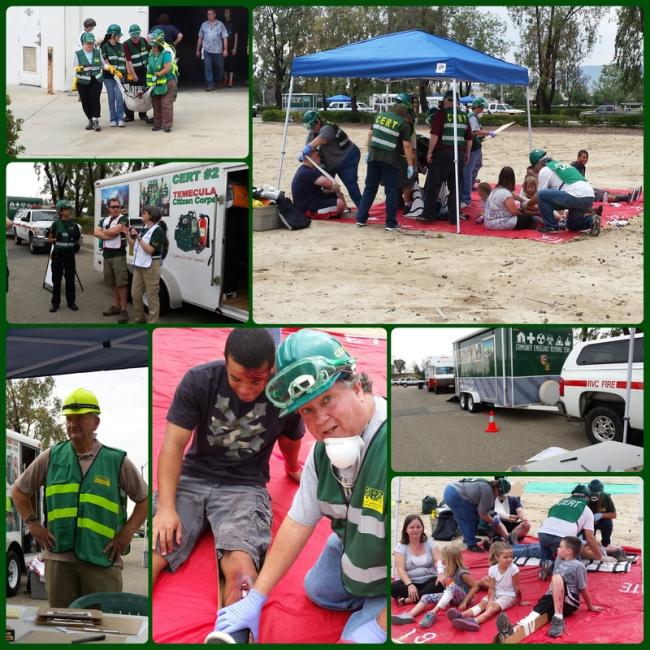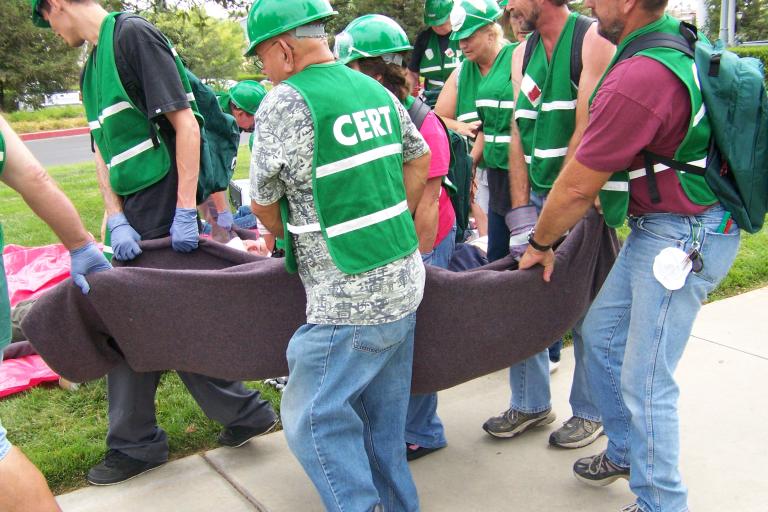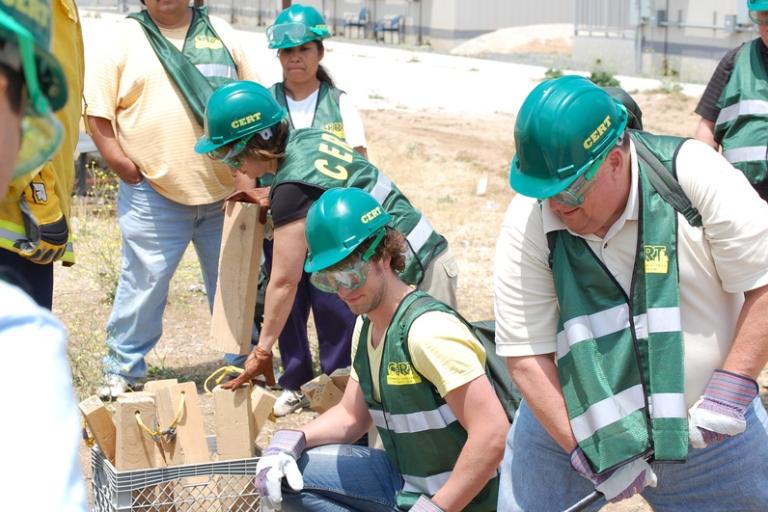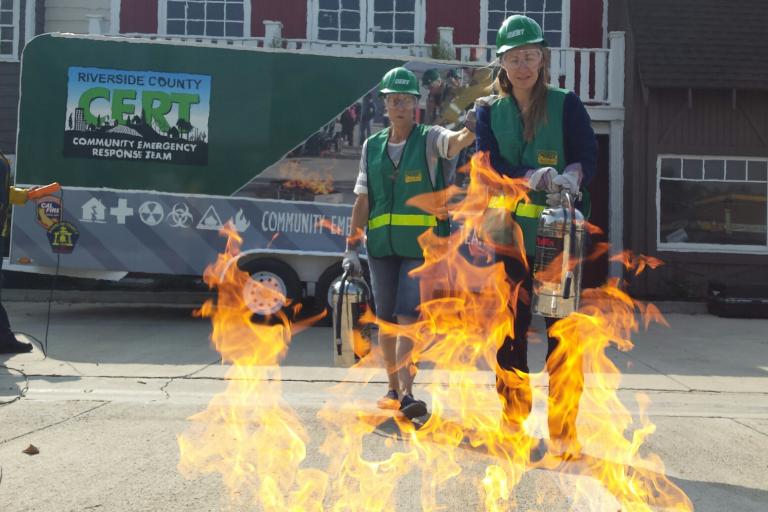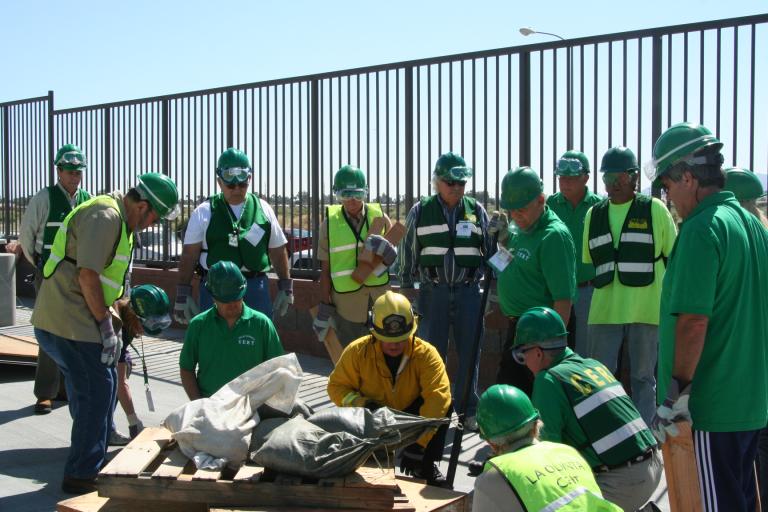Course Summary and Materials
The CERT training is usually delivered over three consecutive days. The training time commitment is a total of 20 hours and consists of the following.
Course materials are provided on the first day of the course, but can also be found below for free.
- CERT Participant Manual - Simplified Chinese
- CERT Participant Manual Hazard Annex - Simplified Chinese
- CERT Participant Manual - Korean
- CERT Participant Manual - Traditional Chinese
- CERT Participant Manual - Vietnamese
See below for a summary of each unit.
UNIT 1 - DISASTER PREPAREDNESS: Addresses hazards to which people are vulnerable in their community. Materials cover actions that participants and their families take before, during, and after a disaster. Topics include:
- Roles and Responsibilities for Community Preparedness: How everyone in a community has a role in disaster preparedness.
- Role of CERTs: CERT organization, disaster and non-disaster roles, and laws that protect disaster workers from liability.
- Elements of Disasters and Their Impact on Infrastructure: The potential effects of extreme emergencies and disasters on electrical service; emergency services; telephone communication; transportation; and availability of food, water, shelter, and fuel.
- Personal and Organizational Preparedness: How you can prepare in advance to improve the quality of your survival and to reduce the damage from hazards.
UNIT 2 - CERT ORGANIZATION: Explains how CERT is organized into a manageable structure. Introduces the Incident Command System (ICS). Topics include:
- CERT Organization: How to organize and deploy CERT resources according to CERT organizational principles.
- CERT Size-up: How to conduct the continual data-gathering and evaluation process at the scene of a disaster or emergency.
- Rescuer Safety: How to protect your own safety and your buddy’s during search and rescue.
- Documentation: Strategies for documenting situation and resource status.
UNIT 3 - DISASTER MEDICAL OPERATIONS PART I: Participants practice diagnosing and treating airway obstruction, bleeding, and shock by using simple triage and rapid treatment techniques. Main topic:
- Assisting Disaster Medical Operations: How to assist by controlling bleeding, maintaining normal body temperature, opening an airway, providing comfort to patients, and applying basic first aid care for a number of injuries.
UNIT 4 - DISASTER MEDICAL OPERATIONS, PART II: Covers evaluating patients by doing a head to toe assessment, establishing a medical treatment area, performing basic first aid, and practicing in a safe and sanitary manner. Topics include:
- Mass Casualty Incidents: How to assist first responders in responding to mass casualty incidents.
- Functions of Disaster Medical Operations: Major functions of disaster medical operations.
- Disaster Medical Treatment Areas: Types of medical treatment areas.
- Head-to-Toe Assessment: How to perform a head-to-toe assessment to identify and treat injuries.
- Public Health Considerations: How to maintain hygiene and sanitation.
UNIT 5 - DISASTER PSYCHOLOGY: Covers signs and symptoms that might be experienced by the disaster victim and worker. Discusses techniques to manage stress during disaster response. Topics include:
- Disaster Psychology: The psychological impact a disaster has on rescuers and survivors, and lessons on providing components of “psychological first aid.”
- Caring for Yourself and Survivors: Steps volunteers can take individually and as part of a CERT before, following, and after a disaster.
UNIT 6 - FIRE SAFETY & UTILITY CONTROLS: Briefly covers fire chemistry, hazardous materials, fire hazards, and fire suppression strategies; the safe use of fire extinguishers, sizing up the situation, controlling utilities, and extinguishing a small fire. Topics include:
- Fire Chemistry: How fire occurs, classes of fire, and choosing the correct means to extinguish each type of fire.
- Fire Size-up Considerations: How to evaluate fires, assess firefighting resources and determine a course of action.
- Portable Fire Extinguishers: How to identify types of portable fire extinguishers and how to operate them.
- Fire Suppression Safety: How to decide if you should attempt to extinguish a fire; how to approach and extinguish a fire safely.
- Hazardous Materials: How to identify potentially dangerous materials in storage, in transit, and in your home.
- Fire and Utility Hazards: How to identify potential fire and utility hazards in the home and workplace; how to implement successful fire prevention strategies.
UNIT 7 - LIGHT SEARCH AND RESCUE OPERATIONS: Participants learn about search and rescue planning, size-up, search techniques, rescue techniques, and most important, rescuer safety. Topics include:
- Search and Rescue Size-up: How to size up the situation in which the search and rescue teams will operate.
- Conducting Interior and Exterior Search Operations: How to search systematically for disaster survivors.
- Conducting Rescue Operations: Safe techniques for lifting, leveraging, cribbing, and survivor removal.
UNIT 8 - CERT & TERRORISM: Participants learn signs of a possible terrorist attack and are given basic instruction on how to avoid becoming a victim. Topics include:
- Terrorism: Defining terrorism, including the goals and tactics of some terrorist groups, and detailing how to respond when an active shooter is in your vicinity.
- Eight Signs of Terrorism: The eight signs of terrorism and how to report suspicious activity.
- Preparing for Your Neighborhood: Steps to take to be prepared at home, work, and in your neighborhood.
- Hazmat and CBRNE: Identifying some basic guidelines during a Hazmat or CBRNE event.
UNIT 9 - COURSE REVIEW AND DISASTER SIMULATION: Participants review and practice the skills that they have learned during the previous six modules. Topics include:
- A Review of Key Points from the Course
- A Final Exam
- A Final Exercise

